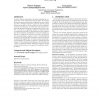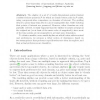972 search results - page 9 / 195 » Using Preference Order in Ontologies |
ATAL
2007
Springer
14 years 1 months ago
2007
Springer
In online, dynamic environments, the services requested by consumers may not be readily served by the providers. This requires the service consumers and providers to negotiate the...
ASP
2005
Springer
14 years 1 months ago
2005
Springer
Preferences are useful when the space of feasible solutions of a given problem is dense but not all these solutions are equivalent w.r.t. some additional requirements. In this case...
DASFAA
2010
IEEE
14 years 16 days ago
2010
IEEE
The skyline of a set P of multi-dimensional points (tuples) consists of those points in P for which no clearly better point in P exists, using component-wise comparison on domains ...
CADE
2007
Springer
14 years 8 months ago
2007
Springer
We present results of our work on using first order theorem proving to reason over a large ontology (the Suggested Upper Merged Ontology ? SUMO), and methods for making SUMO suita...
SPATIALCOGNITION
2004
Springer
14 years 1 months ago
2004
Springer
Abstract. In this paper we apply a formal ontological framework in order to deconstruct two prominent approaches to navigation from cognitive robotics, the Spatial Semantic Hierarc...


